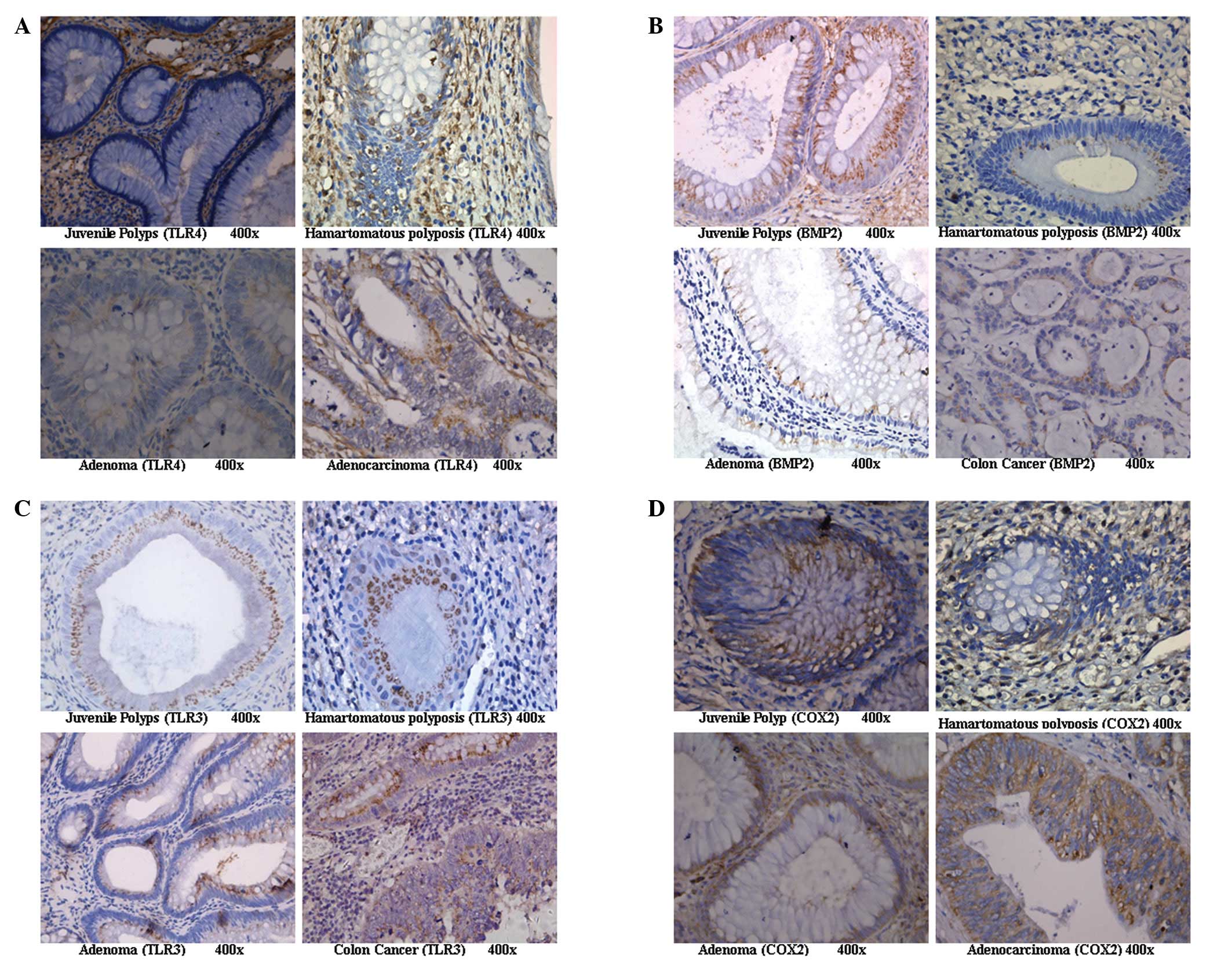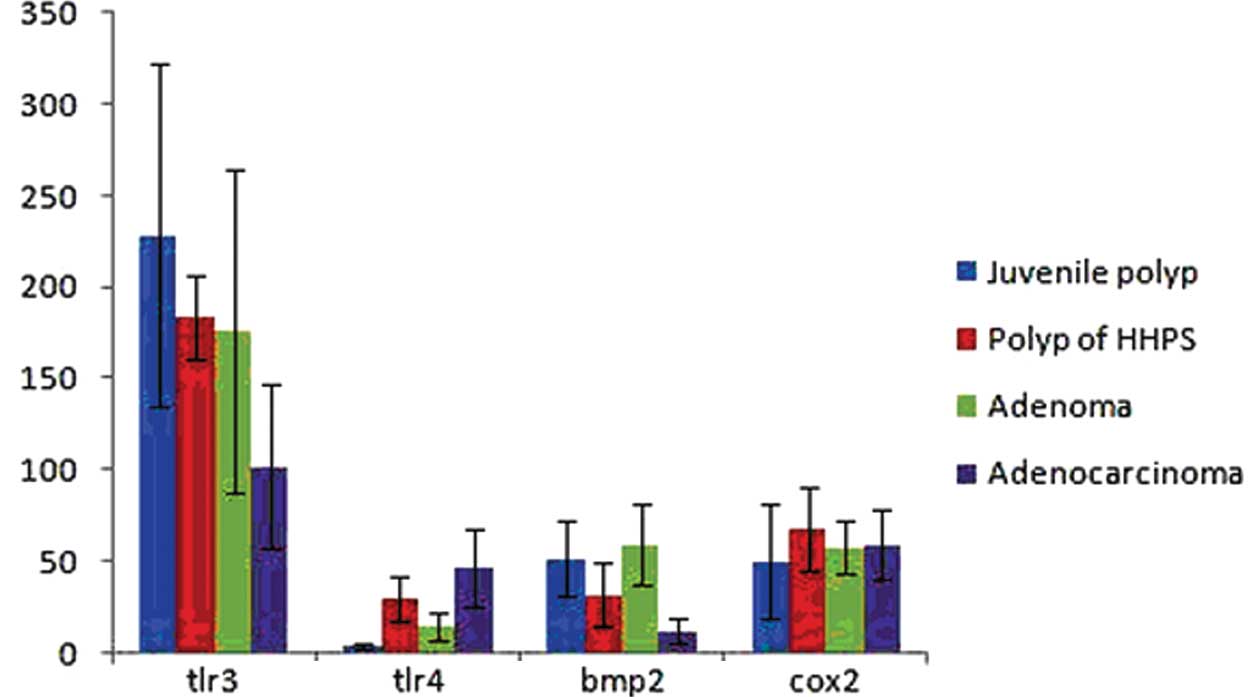Expression of BMP2, TLR3, TLR4 and COX2 in colorectal polyps, adenoma and adenocarcinoma
- Authors:
- Li Xiang
- Shiqi Wang
- Xianqing Jin
- Wenjuan Duan
- Xionghui Ding
- Chang Zheng
-
View Affiliations
Affiliations: Department of Ministry of Education Key Laboratory of Child Development and Disorders and Department of Neonatal Gastrointestinal Surgery, Children's Hospital of Chongqing Medical University, Chongqing 400014, P.R. China, Department of General Surgery, The Second Affiliated Hospital of Chongqing Medical University, Chongqing 400014, P.R. China
- Published online on: August 24, 2012 https://doi.org/10.3892/mmr.2012.1046
-
Pages:
973-976
Metrics:
Total
Views: 0 (Spandidos Publications: | PMC Statistics:
)
Metrics:
Total PDF Downloads: 0 (Spandidos Publications: | PMC Statistics:
)
This article is mentioned in:
Abstract
The initiation and development of colorectal cancer is closely associated with the malignant transformation of colorectal polyps. The aim of this study was to analyze the expression of the bone morphogenetic protein-2 (BMP2), toll-like receptor 3 (TLR3), TLR4 and cyclooxygenase-2 (COX2) proteins in colorectal polyps, adenoma and adenocarcinoma. An immunohistochemical streptavidin-peroxidase (SP) method was used to examine the expression of MBP2, TLR4, TLR3 and COX2 in 20 colorectal juvenile polyps and 15 colorectal polyps of hamartomatous polyposis obtained from children, and 20 colorectal adenomas and 20 colorectal adenocarcinomas obtained from adults. A comparison of the expression levels of TLR3 among the groups revealed a gradual downward trend from the colorectal juvenile polyp group to the colorectal hamartomatous polyposis, adenoma and adenocarcinoma groups, respectively. The expression level of TLR3 was significantly lower in the colorectal adenocarcinoma group (p<0.05). The expression levels of TLR3, TLR4 and BMP2 were significantly different among the colorectal juvenile polyp, hamartomatous polyposis, adenoma and adenocarcinoma groups. These three protein molecules may be significant in the development and malignant transformation of colorectal polyps.
View References
|
1
|
Half E, Gldberg Y, Kariv R, et al:
Guidelines for diagnosis, treatment, surveillance and prevention of
cancer in patients with familiar non-adenomatous polyposis.
Harefuah. 150:602011.PubMed/NCBI
|
|
2
|
Morson BG: Genesis of colorectal cancer.
Clin Gastroenterol. 5:505–507. 1976.
|
|
3
|
Winawer SJ, Zauber AG, Fletcher RH, et al:
Guidelines for colonoscopy surveillance after polypectomy. A
consensus update by the US Multi-Society Task Force on Colorectal
Cancer and the American Cancer Society. Gastroenterol.
130:1872–1885. 2006. View Article : Google Scholar
|
|
4
|
Takeda K, Kaisho T and Akira S: Toll-like
receptors. Annu Rev Immunol. 21:335–367. 2003. View Article : Google Scholar
|
|
5
|
He X and Bai H: Current progress on the
investigation of Toll-like receptor. Northwest National Defense
Medical Journal. 31:445–446. 2010.(In Chinese).
|
|
6
|
Salaun B, Coste I, Rissoan MC, et al: TLR3
can directly trigger apoptosis in human cancer cells. J Immunol.
176:4894–4901. 2006. View Article : Google Scholar : PubMed/NCBI
|
|
7
|
Jin H and Meng Q: Measurement of TLR4
expression in human colon cancer by semi quantitative RT-PCR.
Journal of Modern Applied Medicine. 21:682–684. 2009.(In
Chinese).
|
|
8
|
Bendelac A and Medzhitov R: Adjuvants of
immunity: harnessing innate immunity to promote adaptive immunity.
J Exp Med. 195:F19–F23. 2002. View Article : Google Scholar : PubMed/NCBI
|
|
9
|
He L, Zhang L, Li Z and Zhang Q: The roles
of toll-like receptors in carcinogenesis and cancer immunotherapy.
Chin Ger Journal Clin Oncol. 9:118–120. 2010. View Article : Google Scholar
|
|
10
|
Fiocchi C: TGF-beta/Smad signaling defects
in inflammatory bowel disease: mechanisms and possible novel
therapies for chronic inflammation. J Clin Invest. 108:523–526.
2001. View
Article : Google Scholar : PubMed/NCBI
|
|
11
|
Hardwick JC, Van Den Brink GR, Bleuming
SA, et al: Bone morphogenetic protein 2 is expressed by, and acts
upon, mature epithelial cells in the colon. Gastroenterology.
126:111–121. 2004. View Article : Google Scholar : PubMed/NCBI
|
|
12
|
Zhang F, Warskulat U, Wettstein M, et al:
Hyperosmolarity stimulates prostaglandin synthesis and
cyclooxygenase-2 expression in activated rat liver macrophages.
Biochem J. 312:135–143. 1995.PubMed/NCBI
|
|
13
|
Wasilewicz MP, Kołodziej B, Bojułko T, et
al: Expression of cyclooxygenase-2 in colonic polyps. Pol Arch Med
Wewn. 120:313–320. 2010.PubMed/NCBI
|












